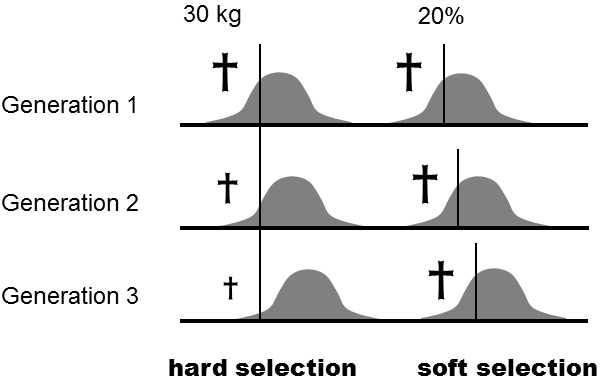IV.2 All types of selection can exist in two basic forms – soft and hard
We speak of hard selection if the selection removes from the population all the individuals whose critical biological parameter, i.e. property that is a measure of the success of the individual under the given conditions, does not attain certain limiting values.For example, all individuals whose body weight is less than 30 kg could be eliminated.In contrast, soft selection ignores the absolute values of a critical trait and eliminates from the population individuals that do not achieve a certain relative value of the given trait, e.g. it eliminates 25% of the smallest individuals in the population.Elimination of the slowest individuals in a herd of ungulates by predators could be an example of soft selection.
From the standpoint of microevolution, soft selection is apparently a more effective evolutionary factor than hard selection (Fig. IV.1).While a species can extricate itself from the effects of hard selection

Fig. IV.1. Hard and soft selection. If hard selection acts on a population, individuals with the value of some trait that does not attain a certain limit are constantly removed from the population, in our case adult individuals weighing less than 30 kg. When the variability in the given trait is genetically determined, over time the population will leave hard selection behind. In contrast, in soft selection, an unvarying percentage of individuals is constantly eliminated from the population, in our case 25% of individuals, in whom the relevant trait deviates the farthest from the population average in a certain direction.
(for example, by increasing its bodily dimensions above a certain critical value), it cannot escape from soft selection; a constant percentage of individuals will be eliminated in every generation without regard to an increase in the mean value of the critical parameter.However, hard selection can be effective over prolonged period of time in a changing environment or in an environment whose properties oscillate in the medium-term.Similarly, from the standpoint of macroevolution, hard selection which, under certain circumstances, can lead to the extinction of a particular species, can apparently be of substantial importance.
